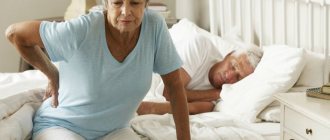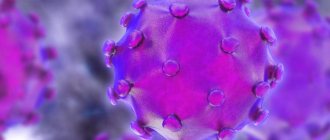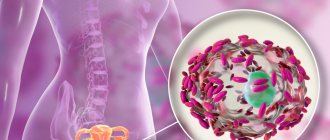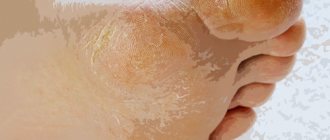Signs and symptoms of osteoporosis
Osteoporosis is a disease that produces few symptoms in the early stages. Signs of pathology appear as bone tissue weakens:
- back pain that occurs with osteoporosis due to destruction of the vertebra;
- slouch;
- reduction in human height;
- fractures even with minor impact (femoral neck fractures are especially dangerous - in 20-25% of cases they lead to death in the first 6 months after injury, and in 40-45% - to disability);
- loose gum tissue;
- pain in the joints, lower back;
- rapid fatigue due to physical exertion;
- discomfort when staying in one position for a long time;
- frequent bowel movements;
- thoracic kyphosis;
- heartburn;
- inability to take a full breath due to chest pain, feeling that there is not enough air;
- accelerated tooth decay;
- leg cramps.
You should consult a doctor for a preventative check if any of these symptoms occur, as well as in the following cases:
- treatment with corticosteroids for several months;
- the beginning of menopause;
- hip fracture in old age.
Early screening for osteoporosis is possible using a blood test, according to which we present the normal indicators according to the following criteria:
- total calcium – from 2.2 to 2.65 mmol/l;
- inorganic phosphorus – from 0.85 to 1.45 µmol/l;
- parathyroid hormone – from 9.5 to 75 pg/ml or from 0.7 to 5.6 pmol/l;
- DPID: for men (nmol DPID/mol creatinine) – from 2.3 to 5.4, for women – from 3 to 7.4;
- osteocalcin (ng/ml): for men - from 12 to 52, for women before menopause - from 6.5 to 42.3, for women after menopause - from 5.4 to 59.1.
Osteoporosis does not manifest itself until 20 to 30% of bone mass is lost. Therefore, after the age of 40, it is recommended to consult an endocrinologist for diagnostics once a year.
How to restore bone health
The success of the therapeutic measures taken will directly depend on the patient’s compliance with all medical prescriptions. In addition to regularly taking medications, it is very important to adjust your lifestyle, establish proper nutrition, so that a sufficient amount of calcium and vitamin D3 enters the body with food.
The main goals of osteoporosis therapy are:
- reducing the risk of fractures;
- increasing bone mass density;
- improvement of markers of bone mass formation.
The patient is advised to control body weight and make all necessary efforts to build muscle tissue. You should also pay attention to saturating the body with calcium and vitamin D. These elements can be supplied with food, and the doctor often prescribes long-term use of medications that contain these minerals and vitamins.
Doctors' recommendations for the treatment of osteoporosis are determined by the stage of severity of the disease and the level of destruction of bone structures. Experts also take into account:
- age category of patients;
- general state;
- severity of symptoms;
- accompanying illnesses.
For elderly people with osteoporosis of the spinal column, therapy consists of taking medications - anabolic steroids, antiresorptive agents. The latter are designed to suppress the processes of destruction of bone structures. Anabolic steroids activate the formation of new bone tissue.
Medications are combined with drugs that contain a high concentration of calcium. If there are severe painful sensations, which often occur with compression fractures of the vertebrae, painkillers must be prescribed in a form convenient for the patient.
For patients diagnosed with a femoral neck fracture, surgical treatment is indicated. The main goal is to restore full function of the joint. Surgical intervention is necessary if there is a high degree of deformation of the chest due to compression injuries of the vertebrae. A certain diet plays a very important role in the treatment of osteoporosis.
Basic principles of nutrition:
- add to the menu dishes that contain a high calcium content. During the day, the human body should receive at least 1200 mg of calcium;
- minimize or completely abandon the consumption of sweets, baked goods, baked goods, and alcoholic beverages;
- include in the diet the daily consumption of fermented milk products, which ensures a regular intake of calcium in the body in soluble form;
- consume more foods that contain magnesium, phosphorus and potassium.
In addition to maintaining proper nutrition, it is important to pay attention to physical activity. In order to properly form a muscle corset that will support bone tissue, it is necessary to provide the body with regular physical activity.
If osteoporosis is detected on time and the patient follows all the doctor’s instructions, the disease will not progress further. The person will be able to lead a normal lifestyle.
Types, forms and degrees of osteoporosis
This disease is classified according to several criteria. First of all, it is considered whether it is an independent (primary) disorder or a symptom of another disease (secondary).
Primary osteoporosis
This is juvenile, postmenopausal, idiopathic, senile osteoprosis.
- The juvenile type of the disease is typical for children and young people, is rare, and is most often caused by birth defects. The main manifestations are severe pain in the legs and back, curvature of the thoracic spine, and visible growth retardation. There is a tendency to compression fractures.
- The postmenopausal form is associated with accelerated bone loss in women 15 to 20 years after menstruation ceases. During this period, estrogens are produced in insufficient quantities and metabolism is disrupted. The disease can be acute or chronic and is accompanied by the occurrence of fractures of bones with a predominantly trabecular structure (vertebrae, distal parts of the radius) i Postnikova S.L. Features of postmenopausal osteoporosis / S.L. Postnikova // General Medicine. - 2004. - No. 4. - P. 41-45. .
- The idiopathic variety is more common in men, but in some cases it is diagnosed in women. The risk group by age is people 20-50 years old. The disease develops smoothly, primarily manifested by periodic pain in the spine, compression fractures are likely.
- Senile osteoporosis is associated with the aging of the body and occurs in both men and women after 70 years of age. Early symptoms are decreased vision, muscle weakness, and migraines. It manifests itself as loss of bone mass in both trabecular and cortical bone, which leads to femoral neck fractures i Postnikova S.L. Features of postmenopausal osteoporosis / S.L. Postnikova // General Medicine. - 2004. - No. 4. - P. 41-45. .
85% of cases of the disease relate to primary osteoporosis, mainly postmenopausal i Lesnyak O.M. Diagnosis, treatment and prevention of osteoporosis in general medical practice. Clinical recommendations / O.M. Lesnyak, N.V. Toroptseva // Russian family doctor. - 2014. - P. 4-17. .
Secondary osteoporosis
Secondary osteoporosis is a complication of various diseases (endocrine, inflammatory, hematological, gastroenterological) or drug therapy (for example, steroid).
Among the forms of secondary osteoporosis, the first place is occupied by glucocorticoid-induced osteoporosis (GIO), which develops in people of any age as a result of therapy with systemic glucocorticosteroids (SGCS).
In elderly patients, a decrease in bone density during long-term therapy with SGCS occurs 2-3 times faster than under physiological conditions. Osteoporotic fractures are reported in 30-50% of patients receiving long-term treatment with glucocorticosteroids. When taking glucocorticosteroids in a daily dose of >5 mc, the risk of fractures increases by 1.9 times compared to the general population, hip fractures by 2 times, vertebral fractures by almost 2.9 times i Baranova I.A. Glucocorticoid-induced osteoporosis / I.A. Baranova // Practical pulmonology. - 2008. - No. 1. - P. 3-9. .
Degrees of osteoporosis
- I (light). Bone density is slightly reduced, sometimes the patient experiences pain in the limbs or spine, and muscle tone decreases. Signs of low calcium levels in the body also appear: dry skin, hair loss, brittle nails.
- II (moderate). Structural changes in the bones are pronounced, the pain becomes constant, and due to damage to the spine, stooping appears. The pain syndrome intensifies with exercise, cramps appear in the calves, and disturbances in the functioning of the heart muscle.
- III (severe). Most of the bones are destroyed, the patient has poor posture, reduced height, and experiences constant severe back pain. Several parts of the spine are affected at once, increasing the risk of fracture of the femoral neck and collarbone.
- IV (very severe). On the x-ray, the bones are almost transparent, the vertebrae are “flattened”, and therefore the patient’s height is significantly reduced, the spinal canal is expanded, and the shape of the bones is changed. At this stage, the patient cannot care for himself.
By localization
The most severe form of the disease is damage to the spine. This increases the risk of getting a fracture and losing the ability to move. Based on localization, the following types of osteoporosis are distinguished:
- Cervical region. The length of the neck decreases, the angle of the head changes. Patients complain of dizziness, nausea, and muscle pain. There is a high risk of pinching the artery that supplies oxygen to the brain.
- Thoracic department. Posture changes noticeably, heart rate increases, and nails become brittle.
- Lumbar region. In this case, the lower back “sags” inward, which reduces the distance between the pelvis and ribs and causes an increase in the abdomen.
By joint damage
Osteoporosis can affect various joints:
- Hip. It is most often affected in old age and leads to disability due to the very low rate of bone tissue restoration. If combined with a spinal fracture, the patient becomes disabled.
- Knee. The cartilage wears out, movement becomes difficult, and severe pain occurs due to the fact that the bones are in contact with each other.
- Ankle. At the same time, it is difficult for a person not only to walk, but also to be at rest. My foot and lower leg hurt constantly.
Diagnosis of osteoporosis
You can check the condition of the body and confirm or exclude the diagnosis of osteoporosis using laboratory tests and instrumental studies, of which the simplest and most informative is densitometry.
Lab tests:
- calcium in urine;
- clinical blood test;
- alkaline phosphatase (biochemistry indicator);
- TSH;
- markers of bone destruction;
- for men – testosterone.
Instrumental methods:
- radiography;
- densitometry;
- bone biopsy;
- bone scintigraphy;
- MRI.
How to check for osteoporosis using densitometry?
Ultrasound densitometry is a quick and painless diagnostic method. During the procedure, the speed of propagation of ultrasound waves through bone tissue is measured. Ultrasound travels faster through denser bones. The result of the study is recorded by a computer, the indicators are compared with the norm. The session lasts 2-3 minutes, and a conclusion is immediately issued.
To carry out this diagnosis, a Sonost-3000 densitometer is used - expert-level equipment that can detect loss of even 2-5% of bone mass.
Densitometry is recommended:
- nulliparous women;
- women over 45 years old;
- women who have given birth to 2 or more children;
- during early menopause;
- in case of menstrual irregularities;
- if you have bad habits;
- men over 50 years old;
- in case of deficiency of sex hormones.
You definitely need to undergo ultrasound densitometry if:
- Fractures often occur;
- there was a long course of glucocorticosteroids, diuretics, anticonvulsants and anticoagulants;
- diagnosed with hyperparathyroidism or other dysfunction of the parathyroid glands.
Also indicated are:
- change in posture;
- bone and muscle pain due to changing weather;
- pain in the lower back and chest with static load;
- senile stoop;
- night cramps in the legs;
- tooth decay;
- decreased growth;
- body weight deficiency;
- osteoporosis in close relatives;
- low testosterone levels in men;
- and etc.
Reasons for women
Osteoporosis is a disease that develops under the influence of many risk factors. There are primary and secondary osteoporosis. Primary osteoporosis develops with age. The reasons are considered to be:
- Complicated family history;
- Mature age;
- Short stature;
- Early menopause and late onset of menstruation;
- Instability of the menstrual cycle;
- Infertility;
- Breastfeeding for longer than one and a half years;
- History of bone fractures;
- Taking hormonal medications;
- Low physical activity;
- Pathology of the endocrine system (thyrotoxicosis, hyperparathyroidism, type 1 diabetes mellitus);
- Excessive drinking and smoking.
Secondary osteoporosis can be caused by the following diseases:
- Itsenko-Cushing's disease and syndrome;
- Thyrotoxicosis;
- Rheumatoid arthritis;
- Diabetes mellitus type 1;
- Conditions after gastric resection,
- Chronic renal failure;
- Chronic liver diseases.
There is a high risk of developing osteoporosis in people taking medications whose side effect is weight loss (immunosuppressants, glucocorticosteroids, anticonvulsants, gonadotropin-releasing hormone antagonists, aluminum-containing antacids).
Smoking, alcohol abuse, caffeine, excess or insufficient physical activity are factors that can cause osteoporosis. The likelihood of developing osteoporosis is higher in people who eat insufficient amounts of calcium, vitamin D, a lot of meat, or cannot tolerate dairy products. Generally recognized factors that increase the risk of developing osteoporosis are the presence of osteoporosis in parents, sisters and brothers, early menopause, and a sedentary lifestyle. Make an appointment
Osteoporosis therapy and clinical recommendations
First of all, you need to know which doctor treats osteoporosis: since the causes of the disease can be different, different specialists can treat it - a rheumatologist, an orthopedic traumatologist, an endocrinologist.
Effective treatment of osteoporosis (both early and after 50 years) may include physiotherapeutic procedures, medication, lifestyle and diet adjustments, and physical exercise.
Drug therapy
- Taking vitamin D and calcium supplements. Consumption of these elements in the right dosages leads to a rapid increase in bone mineral density and a decrease in the incidence of fractures.
- Bisphosphonates. Treatment with these drugs reduces the risk of fractures by 30-50% and increases bone density.
- Hormone therapy (replacement). It is carried out for the prevention and treatment of the postmenopausal form of the disease. Treatment leads to the cessation of bone thinning, the prevention of fractures, and the elimination of urogenital and autonomic complications of menopause.
- Calcitonins. They inhibit bone tissue resorption and have a pronounced analgesic effect.
- Ossein-hydroxyapatite complex. Normalizes calcium homeostasis, improves bone metabolism, stimulates bone formation, restores the balance between the processes of bone formation and resorption.
Non-drug therapy
- Wearing a corset (orthoses)
Indicated for back pain and compression fractures of the spine. The corset should be worn constantly or intermittently, always taking it off at night.
- Physical education, walking, aerobic exercise.
Regular walks in the fresh air are beneficial. Loads should not be excessive; it is necessary to exclude power sports and those that involve the likelihood of mechanical impacts (for example, playing with a ball).
Disease prevention
If a person does not receive the required amount of calcium in his youth, then there is a risk of developing osteoporosis in the future. The diet should contain: dairy products, vegetables, almonds, soy products. It is recommended to drink calcium-containing vitamins.
Calcium absorption requires vitamin D. Its formation depends on exposure to ultraviolet radiation. In older people, the synthesis of this substance is reduced and they require nutritional supplements.
Prevention of osteoporosis for women after 50 years of age is extremely important and should begin at a young age. It is necessary to visit a gynecologist regularly and maintain normal levels of vitamin D. A woman must control her body weight, as otherwise it is negative.
Complications from osteoporosis
The main complication is injuries to the musculoskeletal system, especially compression fractures of the spine and microfractures due to sudden compression of the joints. In this case, a large load is not necessary; you can simply trip and fall, resulting in a fracture.
, compression of the spinal cord and nerve endings may occur . Because of this, loss of sensitivity in various parts of the body, as well as paralysis and disability, is possible.
Fractures are especially dangerous in old age - only 9% of people (according to statistics for the Russian Federation) return to normal life after this.
Osteoporosis can also have the following consequences:
- impediment to growth, which is especially important for a child or adolescent;
- decrease in height - approximately 2-4 cm per year;
- poor posture – “hump” in the thoracic region (thoracic kyphosis);
- disruption of internal organs due to incorrect posture.
Physiotherapy
Physiotherapeutic procedures are effective in treating diseases of the musculoskeletal system.
Electrotherapy includes the following techniques:
- electrophoresis;
- phonophoresis;
- magnetic therapy;
- inhalation therapy;
- EHF;
- ultrasound.
The following treatment methods are also used:
- To improve blood circulation and get rid of swelling in the limbs, lymphatic drainage massage is prescribed. If there is pain, paresis, or weak muscle tone, the doctor prescribes electrical stimulation.
- Light treatment. It is an effective method as part of the complex treatment of diseases of the musculoskeletal system.
- Electromagnetic treatment. Helps in the treatment and prevention of diseases, reduces the severity of the inflammatory process, improves metabolic processes, and relieves post-traumatic consequences. The procedure is performed by exposure to alternating electrical impulses of a certain frequency.
- Treatment with water. It is represented by different types of therapeutic showers and baths. They have a positive effect on bone structures, joints and muscles. Hydromassage is effective because it improves blood flow.
- Massage. Thanks to therapeutic massage, you can get rid of clamps on nerve bundles, fight neuralgia, and remove stagnation of salts and toxins from the body. This procedure helps improve lymph flow and blood circulation. You must take at least one course every 6 months.
- Ozokerite. Helps reduce the severity of the inflammatory process, relieves pain and swelling, and removes toxins. After completing the course, the results last for several months.
- Acupuncture. Helps in rehabilitation after injury and surgery. Accelerates tissue regeneration and restoration of their integrity.
A mandatory step in the treatment of osteoporosis is a properly formulated diet. The body must receive the required amount of calcium and vitamin D. If it is not possible to meet the daily requirement of these elements, the doctor prescribes appropriate medications that contain these components. These multivitamins and calcium supplements will need to be taken over an extended period of time.
Therapeutic exercises should be prescribed by a doctor. In each specific case, an individual treatment regimen is selected. Therefore, it is not recommended to perform any exercises on your own. This can only be done after preliminary consultation with a doctor and work with a rehabilitation specialist.
Sources
- Baranova I.A. Glucocorticoid-induced osteoporosis / I.A. Baranova // Practical pulmonology. - 2008. - No. 1. - P. 3-9.
- Baranova I. Caution: osteoporosis! / I. Baranova // Asthma and allergies. - 2004. - No. 4. - P. 18-19.
- Zulkarneev R.A. Prevention and treatment of osteoporosis / R.A. Zulkarneev, R.R. Zulkarneev // Kazan Medical Journal. - 2003. - T. 84. - No. 3. - P. 230-232.
- Lesnyak O.M. Diagnosis, treatment and prevention of osteoporosis in general medical practice. Clinical recommendations / O.M. Lesnyak, N.V. Toroptseva // Russian family doctor. - 2014. - P. 4-17.
- Postnikova S.L. Features of postmenopausal osteoporosis / S.L. Postnikova // General Medicine. - 2004. - No. 4. - P. 41-45.
- Rodionova I.V. Systemic osteoporosis and osteoporosis of the lower jaw / I.V. Rodionova [and others] // Nurse. - 2015. - No. 5. - P. 32-34.
Postmenopausal period
In the postmenopausal period, correction of osteoporosis is a complex work in two directions.
- Classical measures for the treatment of postmenopausal osteoporosis. In this case, it is necessary to take calcium-containing medications and drugs in combination with vitamin D3, physiotherapy and treatment of concomitant diseases.
- Hormone replacement therapy that corrects the deficiency of the female hormone estrogen.
Sources:
Internet resources
https://etospina.ru
https://www.f-med.ru
https://www.diagnos.ru








